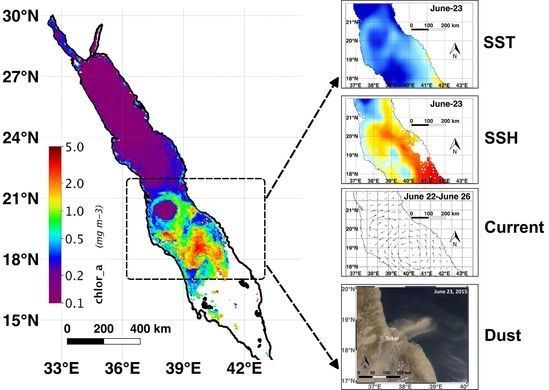Synergistic Use of Remote Sensing and Modeling to Assess an Anomalously High Chlorophyll-a Event during Summer 2015 in the South Central Red Sea
Abstract
:1. Introduction
2. Materials and Methods
2.1. Chlorophyll Data
2.1.1. Terra and Aqua MODIS Data
2.1.2. The Ocean Color Climate Change Initiative (OC-CCI) Data
2.2. Oceanography and Meterology Data
2.2.1. Sea Surface Temperature (SST) Data
2.2.2. Wind Data—ASCAT Global Wind Field L3 Data
2.2.3. Ocean Surface Current Data
2.2.4. Mixed Layer Depth (MLD) and Sea Surface Height (SSH)
2.2.5. Aerosol Optical Depth (AOD) and Dust Aerosol Optical Depth (DAOD) Data
3. Results and Discussion
3.1. Chl-a Climatology in the Read Sea and Anomaly Identification
3.2. Temporal and Spatial Variations of Chl-a Concentration-Related Factors
3.3. Other Factors Contributing to the Chl-a Concentration Variability in the South Central Red Sea
4. Discussion
5. Conclusions
Acknowledgments
Author Contributions
Conflicts of Interest
References
- Naval Oceanography Command Detachment. US Navy Regional Climatic Study of the Red Sea and Adjacent Waters; National Oceanic and Atmospheric Administration: Asheville, NC, USA, 1993.
- Smeed, D.A. Exchange through the Bab el Mandab. Deep Sea Res. Part II Top. Stud. Oceanogr. 2004, 51, 455–474. [Google Scholar] [CrossRef]
- Zhan, P.; Subramanian, A.C.; Yao, F.; Hoteit, I. Eddies in the Red Sea: A statistical and dynamical study. J. Geophys. Res. Oceans 2014, 119, 3909–3925. [Google Scholar] [CrossRef]
- Shaikh, E.A.; Roff, J.C.; Dowidar, N.M. Phytoplankton ecology and production in the Red Sea off Jiddah, Saudi Arabia. Mar. Biol. 1986, 92, 405–416. [Google Scholar] [CrossRef]
- Pedgley, D.E. An outline of the weather and climate of the Red Sea. L’Oceanogr. Phys. Mer Rouge 1974, 9–27. [Google Scholar]
- Grasshoff, K. The hydrochemistry of landlocked basins and fjords. Chem. Oceanogr. 1975, 2, 455–597. [Google Scholar]
- Edwards, F.J. Climate and oceanography. In Red Sea Key Environment Series; Pergamon: Amsterdam, The Netherlands, 1987; pp. 45–69. ISBN 978-0-08-028873-4. [Google Scholar]
- Halim, Y. Plankton of the Red Sea and the Arabian Gulf. Deep Sea Res. Part A. Oceanogr. Res. Pap. 1984, 31, 969–982. [Google Scholar] [CrossRef]
- Sheppard, C.J.R.; Price, A.; Roberts, C. Marine Ecology of the Arabian Region: Patterns and Processes in Extreme Tropical Environments, 1st ed.; Academic Press: London, UK, 1992; ISBN 978-0-12-639490-0. [Google Scholar]
- Sofianos, S.S.; Johns, W.E. Observations of the summer Red Sea circulation. J. Geophys. Res. 2007, 112, C06025. [Google Scholar] [CrossRef]
- Froese, R.; Pauly, D. (Eds.) World Wide Web Electronic Publication, www.fishbase.org, version (02/2017); FishBase: Los Baños, Philippines, 2017. [Google Scholar]
- Price, A.R.G.; Ghazi, S.J.; Tkaczynski, P.J.; Venkatachalam, A.J.; Santillan, A.; Pancho, T.; Metcalfe, R.; Saunders, J. Shifting environmental baselines in the Red Sea. Mar. Poll. Bull. 2014, 78, 96–101. [Google Scholar] [CrossRef] [PubMed]
- Transboundary Water Assessment Programme. LME 33—Red Sea; Transboundary Water Assessment Programme: Nairobi, Kenya, 2015; p. 13. Available online: http://onesharedocean.org/LME_33_Red_Sea (accessed on 1 May 2017).
- Berumen, M.L.; Hoey, A.S.; Bass, W.H.; Bouwmeester, J.; Catania, D.; Cochran, J.E.M.; Khalil, M.T.; Miyake, S.; Mughal, M.R.; Spaet, J.L.Y.; et al. The status of coral reef ecology research in the Red Sea. Coral Reefs 2013, 32, 737–748. [Google Scholar] [CrossRef]
- Cantin, N.E.; Cohen, A.L.; Karnauskas, K.B.; Tarrant, A.M.; McCorkle, D.C. Ocean warming slows coral growth in the central Red Sea. Science 2010, 329, 322–325. [Google Scholar] [CrossRef] [PubMed]
- Qurban, M.A.; Balala, A.C.; Kumar, S.; Bhavya, P.S.; Wafar, M. Primary production in the northern Red Sea. J. Mar. Syst. 2014, 132, 75–82. [Google Scholar] [CrossRef]
- Raitsos, D.E.; Pradhan, Y.; Brewin, R.J.W.; Stenchikov, G.; Hoteit, I. Remote sensing the phytoplankton seasonal succession of the Red Sea. PLoS ONE 2013, 8, e64909. [Google Scholar] [CrossRef] [PubMed]
- Wafar, M.; Ashraf, M.; Manikandan, K.P.; Qurban, M.A.; Kattan, Y. Propagation of Gulf of Aden Intermediate Water (GAIW) in the Red Sea during autumn and its importance to biological production. J. Mar. Syst. 2016, 154, 243–251. [Google Scholar] [CrossRef]
- Wafar, M.; Qurban, M.A.; Ashraf, M.; Manikandan, K.P.; Flandez, A.V.; Balala, A.C. Patterns of distribution of inorganic nutrients in Red Sea and their implications to primary production. J. Mar. Syst. 2016, 156, 86–98. [Google Scholar] [CrossRef]
- Qurban, M.A.; Wafar, M.; Jyothibabu, R.; Manikandan, K.P. Patterns of primary production in the Red Sea. J. Mar. Syst. 2017, 169, 87–98. [Google Scholar] [CrossRef]
- Patzert, W.C. Wind-induced reversal in Red Sea circulation. Deep-Sea Res. 1974, 21, 109–121. [Google Scholar] [CrossRef]
- Acker, J.; Leptoukh, G.; Shen, S.; Zhu, T.; Kempler, S. Remotely-sensed chlorophyll a observations of the northern Red Sea indicate seasonal variability and influence of coastal reefs. J. Mar. Syst. 2008, 69, 191–204. [Google Scholar] [CrossRef]
- Siegel, D.A.; Behrenfeld, M.J.; Maritorena, S.; McClain, C.R.; Antoine, D.; Bailey, S.W.; Bontempi, P.S.; Boss, E.S.; Dierssen, H.M.; Doney, S.C.; et al. Regional to global assessments of phytoplankton dynamics from the SeaWiFS mission. Remote Sens. Environ. 2013, 135, 77–91. [Google Scholar] [CrossRef]
- Franz, B.A.; Kwiatkowska, E.J.; Meister, G.; McClain, C.R. Moderate Resolution Imaging Spectroradiometer on Terra: Limitations for ocean color applications. J. Appl. Remote Sens. 2008, 2, 023525. [Google Scholar] [CrossRef]
- Kwiatkowska, E.J.; Franz, B.A.; Meister, G.; McClain, C.R.; Xiong, X. Cross calibration of ocean-color bands from moderate resolution imaging spectroradiometer on terra platform. Appl. Opt. 2008, 47, 6796–6810. [Google Scholar] [CrossRef] [PubMed]
- Brewin, R.J.W.; Raitsos, D.E.; Pradhan, Y.; Hoteit, I. Comparison of chlorophyll in the Red Sea derived from MODIS-Aqua and in vivo fluorescence. Remote Sens. Environ. 2013, 136, 218–224. [Google Scholar] [CrossRef]
- Arun Kumar, S.V.V.; Babu, K.N.; Shukla, A.K. Comparative analysis of Chlorophyll-a distribution from SeaWiFS, MODIS-Aqua, MODIS-Terra and MERIS in the Arabian Sea. Mar. Geodesy. 2015, 38, 40–57. [Google Scholar] [CrossRef]
- Gregg, W.W.; Casey, N.W. Global and regional evaluation of the SeaWiFS chlorophyll data set. Remote Sens. Environ. 2004, 93, 463–479. [Google Scholar] [CrossRef]
- Feng, L.; Hu, C. Comparison of valid ocean observations between MODIS Terra and Aqua over the global ocean. IEEE Trans. Geosci. Remote Sens. 2016, 54, 1575–1585. [Google Scholar] [CrossRef]
- Racault, M.-F.; Raitsos, D.E.; Berumen, M.L.; Brewin, R.J.W.; Platt, T.; Sathyendranath, S.; Hoteit, I. Phytoplankton phenology indices in coral reef ecosystems: Application to ocean-color observations in the Red Sea. Remote Sens. Environ. 2015, 160, 222–234. [Google Scholar] [CrossRef]
- Dreano, D.; Raitsos, D.E.; Gittings, J.; Krokos, G.; Hoteit, I. The Gulf of Aden intermediate water intrusion regulates the southern Red Sea summer phytoplankton blooms. PLoS ONE 2016, 11, e0168440. [Google Scholar] [CrossRef] [PubMed]
- NASA Goddard Space Flight Center. O.E. L. MODIS-Terra Ocean Color Data 2014; NASA Goddard Space Flight Center: Greenbelt, MD, USA, 2014.
- NASA Goddard Space Flight Center. O.E. L. MODIS-Aqua Ocean Color Data 2014; NASA Goddard Space Flight Center: Greenbelt, MD, USA, 2014.
- Sathyendranath, S.; Brewin, R.J.W.; Jackson, T.; Mélin, F.; Platt, T. Ocean-colour products for climate-change studies: What are their ideal characteristics? Remote Sens. Environ. 2017, in press. [Google Scholar] [CrossRef]
- Mélin, F.; Vantrepotte, V.; Chuprin, A.; Grant, M.; Jackson, T.; Sathyendranath, S. Assessing the fitness-for-purpose of satellite mutli-mission ocean color climate data records: A protocol applied to OC-CCI chlorophyll-a data. Remote Sens. Environ. 2017, in press. [Google Scholar] [CrossRef]
- Mélin, F.; Sclep, G. Band shifting for ocean color multi-spectral reflectance data. Opt. Express 2015, 23, 2262–2279. [Google Scholar] [CrossRef] [PubMed]
- ESA CCI Ocean Colour Website. Available online: http://www.esa-oceancolour-cci.org/ (accessed on 28 June 2017).
- Chao, Y.; Li, Z.; Farrara, J.D.; Hung, P. Blending sea surface temperatures from multiple satellites and in situ observations for coastal oceans. J. Atmos. Ocean. Technol. 2009, 26, 1415–1426. [Google Scholar] [CrossRef]
- Donlon, C.J.; Martin, M.; Stark, J.; Roberts-Jones, J.; Fiedler, E.; Wimmer, W. The Operational Sea Surface Temperature and Sea Ice Analysis (OSTIA) system. Remote Sens. Environ. 2012, 116, 140–158. [Google Scholar] [CrossRef]
- JPL Our Ocean. GHRSST Level 4 G1SST Global Foundation Sea Surface Temperature Analysis; JPL OurOcean Project; NASA PO.DAAC: Pasadena, CA, USA, 2010. Available online: http://dx.doi.org/10.5067/GHG1S-4FP01 (accessed on 31 March 2017).
- Figa-Saldaña, J.; Wilson, J.J.W.; Attema, E.; Gelsthorpe, R.; Drinkwater, M.R.; Stoffelen, A. The advanced scatterometer (ASCAT) on the meteorological operational platform: A follow on for European wind scatterometers. Can. J. Remote Sens. 2002, 28, 404–412. [Google Scholar] [CrossRef]
- Bentamy, A.; Fillon, D.C. Gridded surface wind fields from Metop/ASCAT measurements. Int. J. Remote Sens. 2012, 33, 1729–1754. [Google Scholar] [CrossRef]
- Dohan, K.; Maximenko, N. Monitoring ocean currents with satellite sensors. Oceanography 2010, 23, 94–103. [Google Scholar] [CrossRef]
- Earth Space Research. OSCAR Third Degree Resolution Ocean Surface Currents; Earth Space Research: Seattle, WA, USA, 2009. [Google Scholar]
- Bonjean, F.; Lagerloef, G.S.E. Diagnostic model and analysis of the surface currents in the tropical Pacific Ocean. J. Phys. Oceanogr. 2002, 32, 2938–2954. [Google Scholar] [CrossRef]
- Bleck, R. An oceanic general circulation model framed in hybrid isopycnic-Cartesian coordinates. Ocean Model. 2002, 4, 55–88. [Google Scholar] [CrossRef]
- Cummings, J.A. Operational multivariate ocean data assimilation. Q. J. Roy. Meteorol. Soc. 2005, 131, 3583–3604. [Google Scholar] [CrossRef]
- Cummings, J.A.; Smedstad, O.M. Variational data assimilation for the global ocean. In Data Assimilation for Atmospheric, Oceanic and Hydrologic Applications (Vol. II); Park, S.K., Xu, L., Eds.; Springer: Berlin/Heidelberg, Germany, 2013; pp. 303–343. [Google Scholar] [CrossRef]
- Mahowald, N.M.; Baker, A.R.; Bergametti, G.; Brooks, N.; Duce, R.A.; Jickells, T.D.; Kubilay, N.; Prospero, J.M.; Tegen, I. Atmospheric global dust cycle and iron inputs to the ocean. Glob. Biogeochem. Cycles 2005, 19, GB4025. [Google Scholar] [CrossRef]
- Schulz, M.; Prospero, J.M.; Baker, A.R.; Dentener, F.; Ickes, L.; Liss, P.S.; Mahowald, N.M.; Nickovic, S.; García-Pando, C.P.; Rodríguez, S.; et al. Atmospheric transport and deposition of mineral dust to the ocean: Implications for research needs. Environ. Sci. Technol. 2012, 46, 10390–10404. [Google Scholar] [CrossRef] [PubMed]
- Levy, R.C.; Mattoo, S.; Munchak, L.A.; Remer, L.A.; Sayer, A.M.; Patadia, F.; Hsu, N.C. The Collection 6 MODIS aerosol products over land and ocean. Atmos. Meas. Tech. 2013, 6, 2989–3034. [Google Scholar] [CrossRef]
- Berrick, S.W.; Leptoukh, G.; Farley, J.D.; Rui, H. Giovanni: A web service workflow-based data visualization and analysis system. IEEE Trans. Geosci. Remote Sens. 2009, 47, 106–113. [Google Scholar] [CrossRef]
- Randles, C.A.; da Silva, A.M.; Buchard, V.; Colarco, P.R.; Darmenov, A.; Govindaraju, R.; Smirnov, A.; Holben, B.; Ferrare, R.; Hair, J.; et al. The MERRA-2 aerosol reanalysis, 1980—Onward, Part I: System description and data assimilation evaluation. J. Clim. 2017, in press. [Google Scholar] [CrossRef]
- Hovmöller, E. The trough-and-ridge diagram. Tellus 1949, 1, 62–66. [Google Scholar] [CrossRef]
- Quadfasel, D.; Baudner, H. Gyre-scale circulation cells in the Red Sea. Oceanol. Acta 1993, 16, 221–229. [Google Scholar] [CrossRef]
- Brindley, H.; Osipov, S.; Bantges, R.; Smirnov, A.; Banks, J.; Levy, R.; Jish Prakash, P.; Stenchikov, G. An assessment of the quality of aerosol retrievals over the Red Sea and evaluation of the climatological cloud-free dust radiative effect in the region. J. Geophys. Res. Atmos. 2015, 120, 10862–10878. [Google Scholar] [CrossRef]
- Jish Prakash, P.; Stenchikov, G.; Kalenderski, S.; Osipov, S.; Bangalath, H. The impact of dust storms on the Arabian Peninsula and the Red Sea. Atmos. Chem. Phys. 2015, 15, 199–222. [Google Scholar] [CrossRef]
- Fu, L.-L.; Christensen, E.J.; Yamarone, C.A., Jr.; Lefebvre, M.; Ménard, Y.; Dorrer, M.; Escudier, P. TOPEX/POSEIDON mission overview. J. Geophys. Res. 1994, 99, 24369–24381. [Google Scholar] [CrossRef]
- Zhai, P.; Bower, A. The response of the Red Sea to a strong wind jet near the Tokar Gap in summer. J. Geophys. Res. Oceans 2013, 118, 422–434. [Google Scholar] [CrossRef]
- Yao, F.; Hoteit, I.; Pratt, L.J.; Bower, A.S.; Zhai, P.; Köhl, A.; Gopalakrishnan, G. Seasonal overturning circulation in the Red Sea: 1. Model validation and summer circulation. J. Geophys. Res. Oceans 2014, 119, 2238–2262. [Google Scholar] [CrossRef]
- Cromwell, D.; Smeed, D.A. Altimetric observations of sea level cycles near the Strait of Bab al Mandab. Int. J. Remote Sens. 1998, 19, 1561–1578. [Google Scholar] [CrossRef]
- Wahr, J.; Smeed, D.A.; Leuliette, E.; Swenson, S. Seasonal variability of the Red Sea, from satellite gravity, radar altimetry, and in situ observations. J. Geophys. Res. Oceans 2014, 119, 5091–5104. [Google Scholar] [CrossRef] [Green Version]
- Jiang, J.; Farrar, J.T.; Beardsley, R.C.; Chen, R.; Chen, C. Zonal surface wind jets across the Red Sea due to mountain gap forcing along both sides of the Red Sea. Geophys. Res. Lett. 2009, 36, L19605. [Google Scholar] [CrossRef]
- Ralston, D.K.; Jiang, H.; Farrar, J.T. Waves in the Red Sea: Response to monsoonal and mountain gap winds. Cont. Shelf Res. 2013, 65, 1–13. [Google Scholar] [CrossRef]
- Langodan, S.; Cavaleri, L.; Viswanadhapalli, Y.; Hoteit, I. The Red Sea: A natural laboratory for wind and wave modeling. J. Phys. Oceanogr. 2014, 44, 3139–3159. [Google Scholar] [CrossRef]
- Hickey, B.; Goudie, A.S. The use of TOMS and MODIS to identify dust storm source areas: The Tokar Delta (Sudan) and the Seistan Basin (southwest Asia). In Geomorphological Variations; Goudie, A.S., Kalvoda, J., Eds.; P3K: Prague, Czech Republic, 2007; pp. 37–57. [Google Scholar]
- Churchill, J.H.; Lentz, S.J.; Farrar, J.T.; Abualnaja, Y. Properties of Red Sea coastal currents. Cont. Shelf Res. 2014, 78, 51–61. [Google Scholar] [CrossRef]
- Raitsos, D.E.; Yi, X.; Platt, T.; Racault, M.-F.; Brewin, R.J.W.; Pradhan, Y.; Papadopoulos, V.P.; Sathyendranath, S.; Hoteit, I. Monsoon oscillations regulate fertility of the Red Sea. Geophys. Res. Lett. 2015, 42, 855–862. [Google Scholar] [CrossRef]
- Box, G.E.P.; Pierce, D.A. Distribution of residual autocorrelations in autoregressive-integrated moving average time series models. J. Am. Stat. Assoc. 1970, 65, 1509–1526. [Google Scholar] [CrossRef]
- Neumann, A.C.; McGill, D.A. Circulation of the Red Sea in early summer. Deep Sea Res. 1953 1961, 8, 223–235. [Google Scholar] [CrossRef]
- Phillips, O.M. On turbulent convection currents and the circulation of the Red Sea. Deep Sea Res. Oceanogr. Abstr. 1966, 13, 1149–1160. [Google Scholar] [CrossRef]
- Sofianos, S.S.; Johns, W.E. An Oceanic General Circulation Model (OGCM) investigation of the Red Sea circulation, 1. Exchange between the Red Sea and the Indian Ocean. J. Geophys. Res. 2002, 107. [Google Scholar] [CrossRef]
- Churchill, J.H.; Bower, A.S.; McCorkle, D.C.; Abualnaja, Y. The transport of nutrient-rich Indian Ocean water through the Red Sea and into coastal reef systems. J. Mar. Res. 2014, 72, 165–181. [Google Scholar] [CrossRef]
- McGillicuddy, D.J., Jr.; Robinson, A.R.; Siegel, D.A.; Jannasch, H.W.; Johnson, R.; Dickey, T.D.; McNeil, J.; Michaels, A.F.; Knap, A.H. Influence of mesoscale eddies on new productions in the Sargasso Sea. Nature 1998, 394, 263–266. [Google Scholar] [CrossRef]
- Lévy, M.; Klein, P.; Treguier, A.-M. Impact of sub-mesoscale physics on production and subduction of phytoplankton in an oligotrophic regime. J. Mar. Res. 2001, 59, 535–565. [Google Scholar] [CrossRef]
- Lima, I.D.; Olson, D.B.; Doney, S.C. Biological response to frontal dynamics and mesoscale variability in oligotrophic environments: Biological production and community structure. J. Geophys. Res. 2002, 107, 3111. [Google Scholar] [CrossRef]
- Zhong, Y.; Bracco, A.; Tian, J.; Dong, J.; Zhao, W.; Zhang, Z. Observed and simulated submesoscale vertical pump of an anticyclonic eddy in the South China Sea. Sci. Rep. 2017, 7, 44011. [Google Scholar] [CrossRef] [PubMed]
- Chen, C.; Li, R.; Pratt, L.; Limeburner, R.; Beardsley, R.C.; Bower, A.; Jiang, H.; Abualnaja, Y.; Xu, Q.; Lin, H.; Liu, X.; Lan, J.; et al. Process modeling studies of physical mechanisms of the formation of an anticyclonic eddy in the central Red Sea. J. Geophys. Res. Oceans 2014, 119, 1445–1464. [Google Scholar] [CrossRef]
- Patra, P.K.; Kumar, M.D.; Mahowald, N.; Sarma, V.V.S.S. Atmospheric deposition and surface stratification as controls of contrasting chlorophyll abundance in the North Indian Ocean. J. Geophys. Res. 2007, 112, C05029. [Google Scholar] [CrossRef]
- Nezlin, N.P.; Polikarpov, I.G.; Al-Yanami, F.Y.; Rao, D.V.S.; Ignatov, A.M. Satellite monitoring of climatic factors regulating phytoplankton variability in the Arabian (Persian) Gulf. J. Mar. Syst. 2010, 82, 47–60. [Google Scholar] [CrossRef]
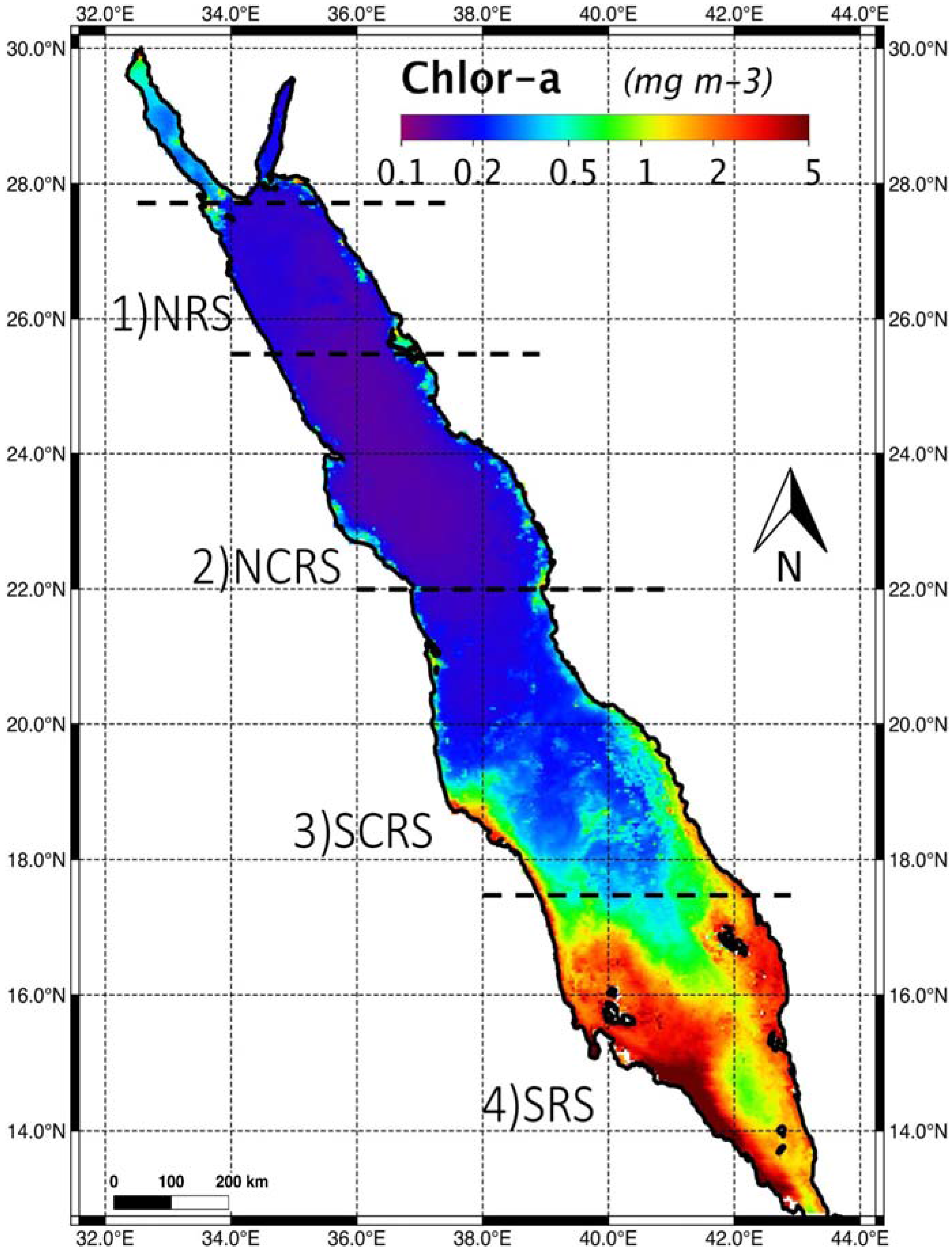

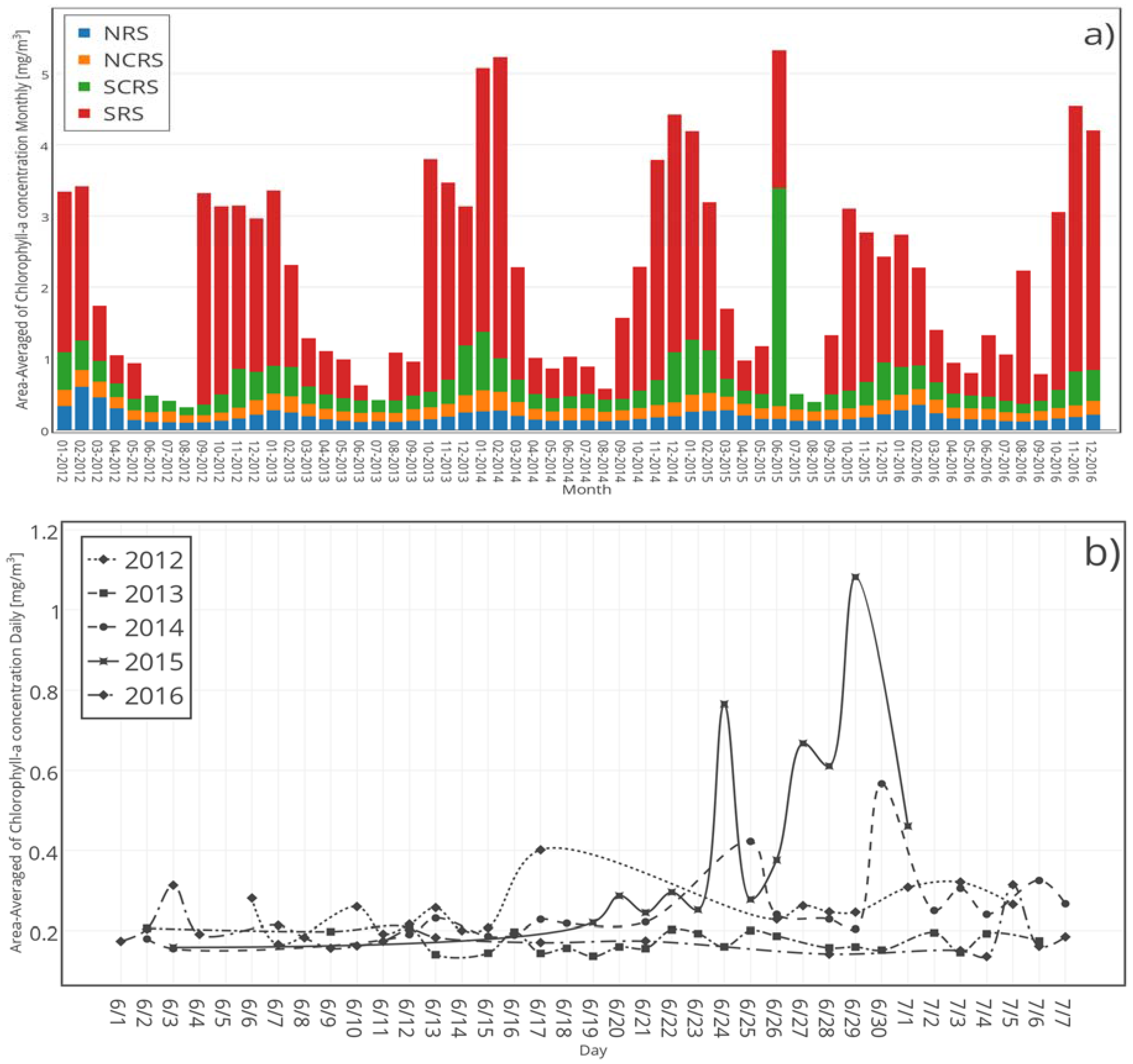

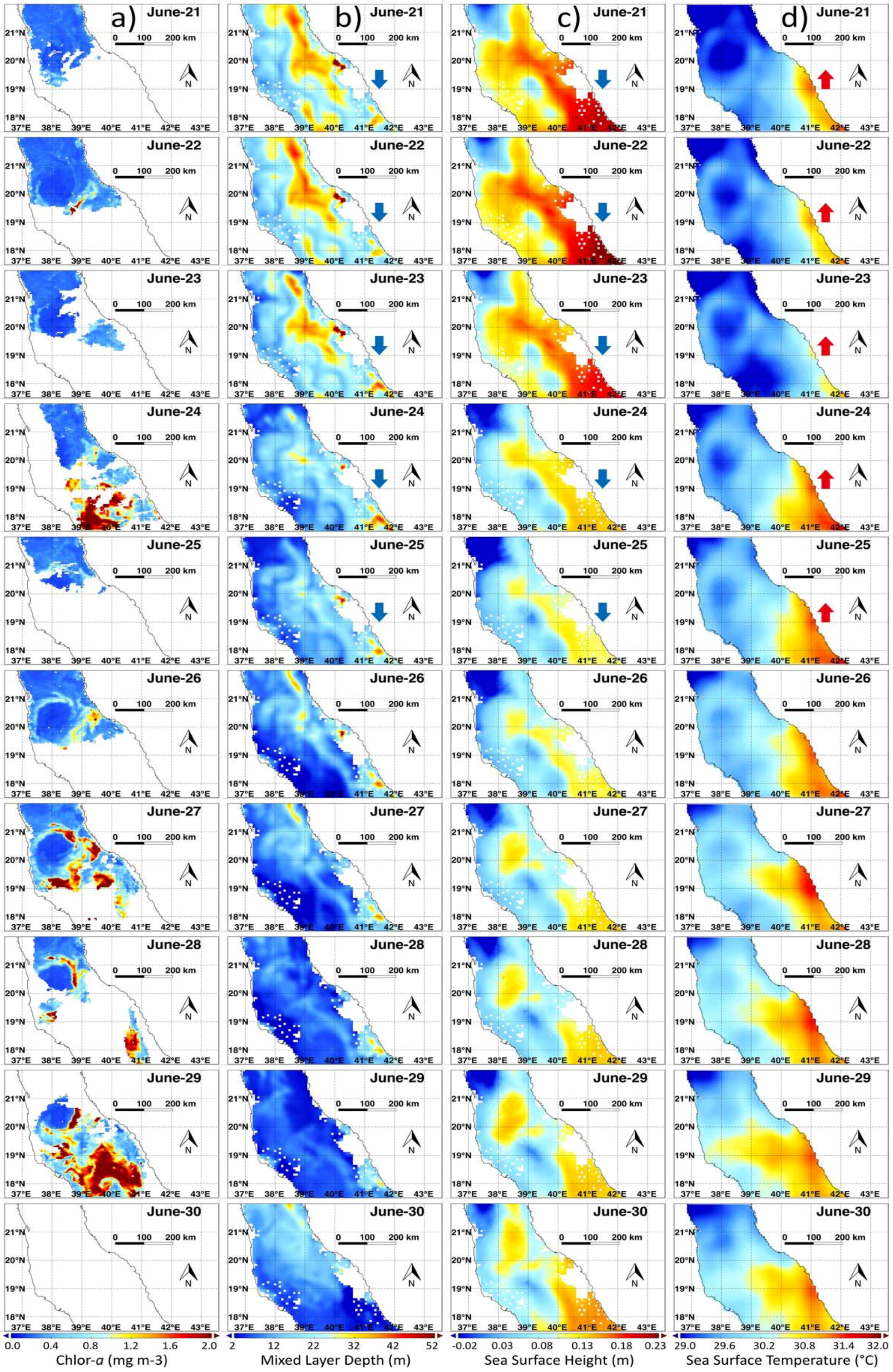
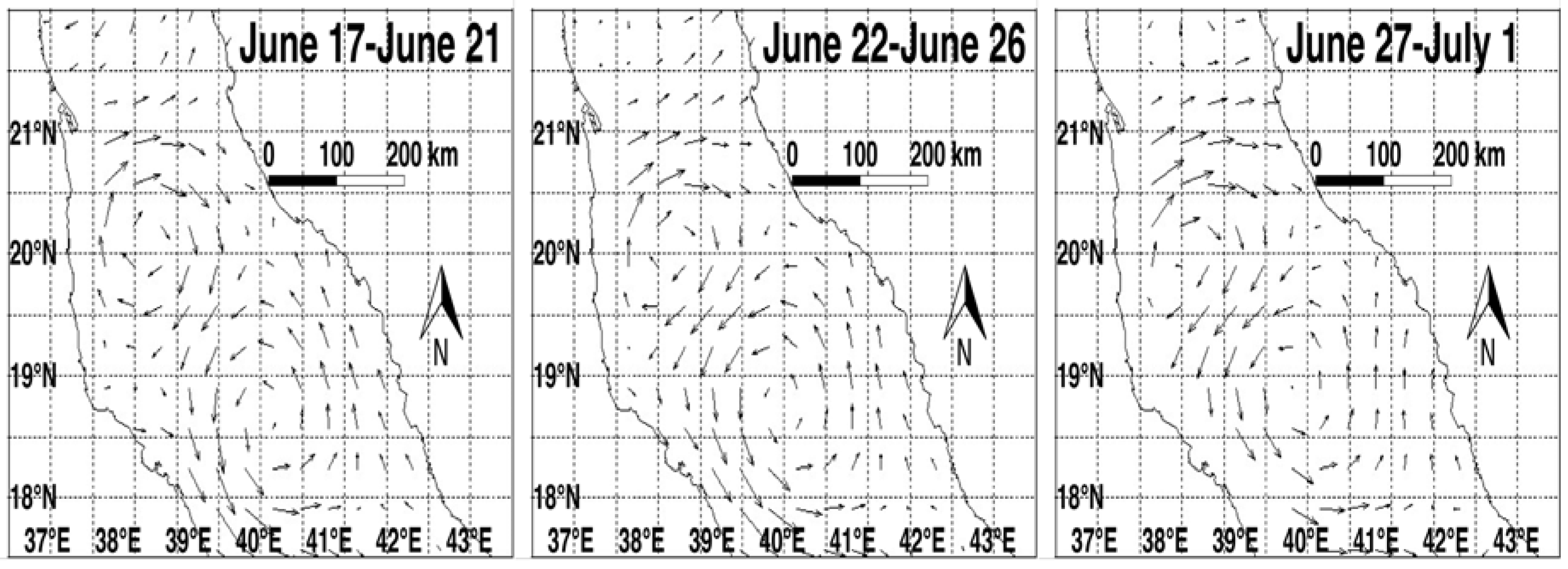
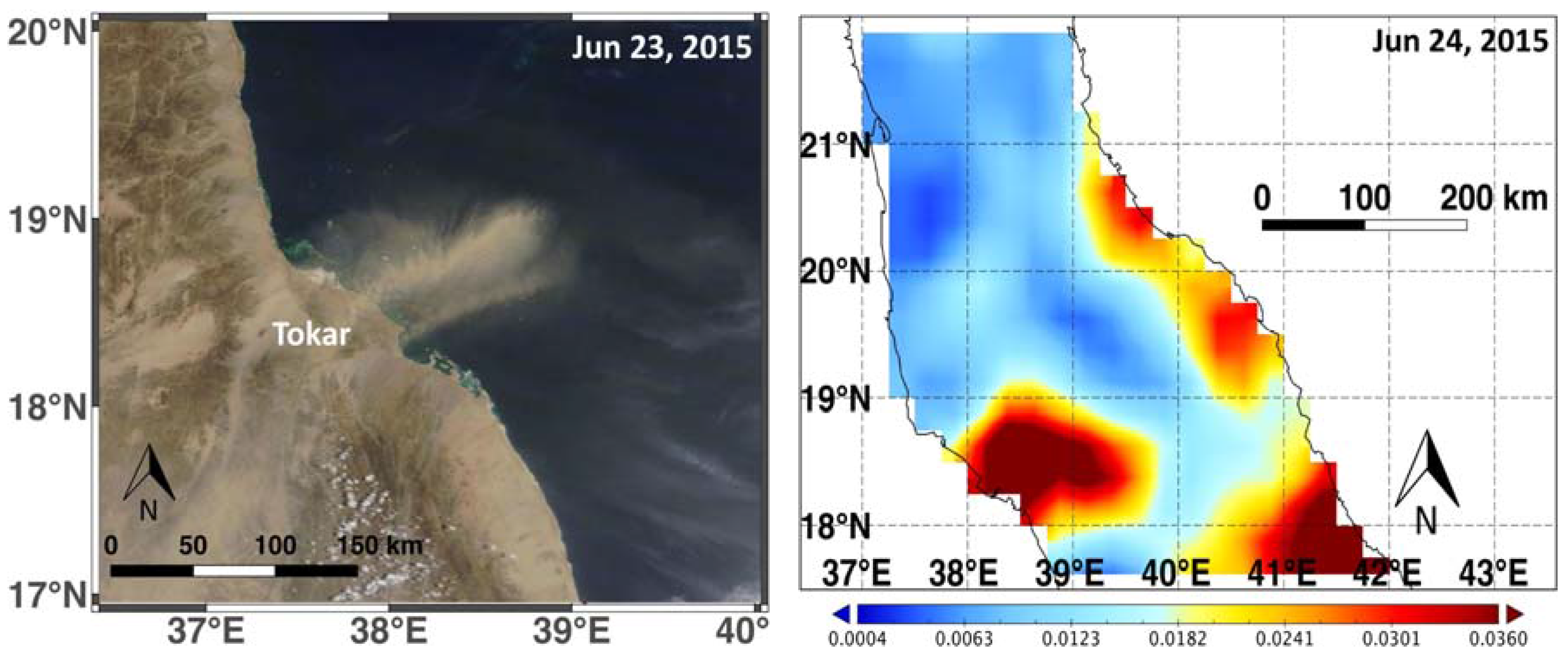
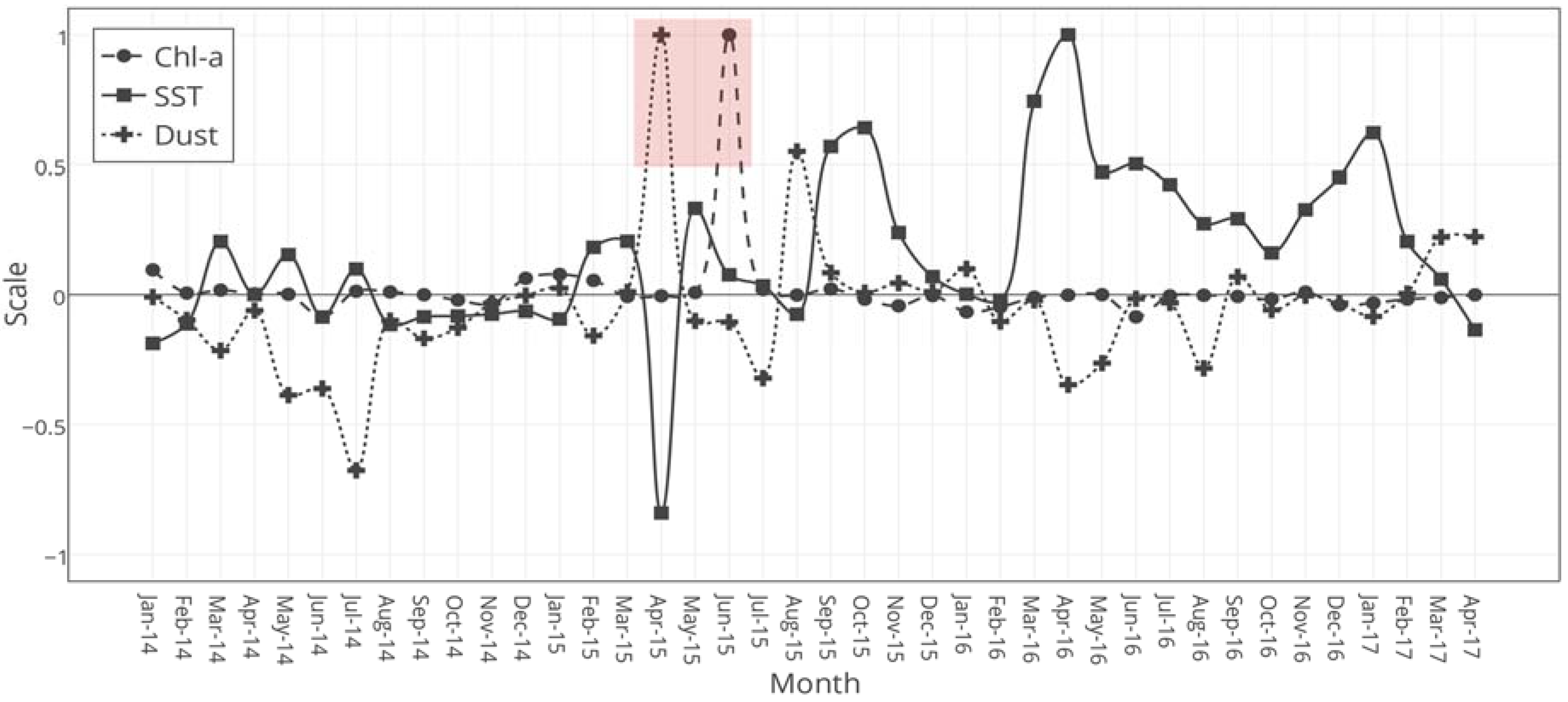
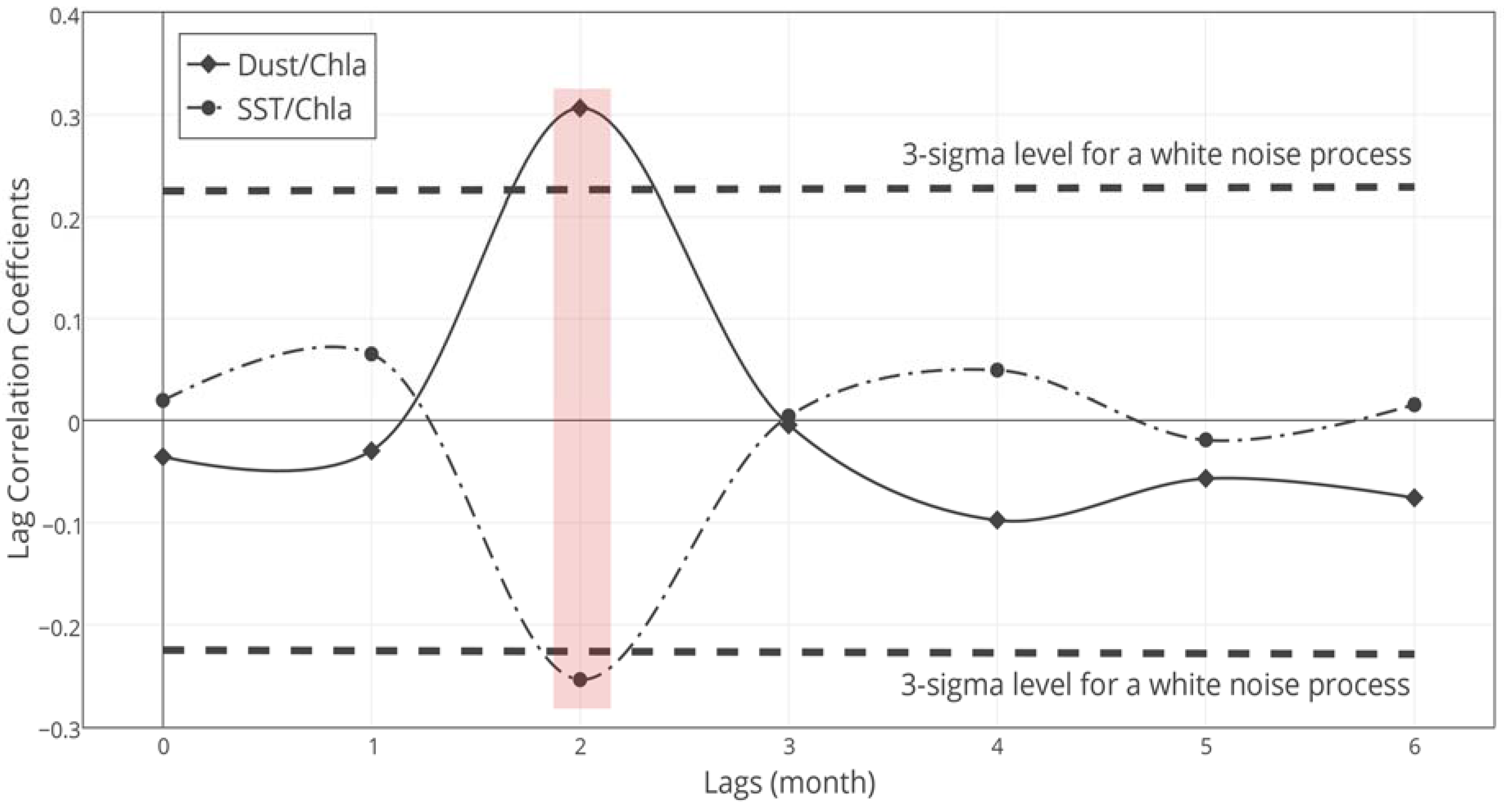
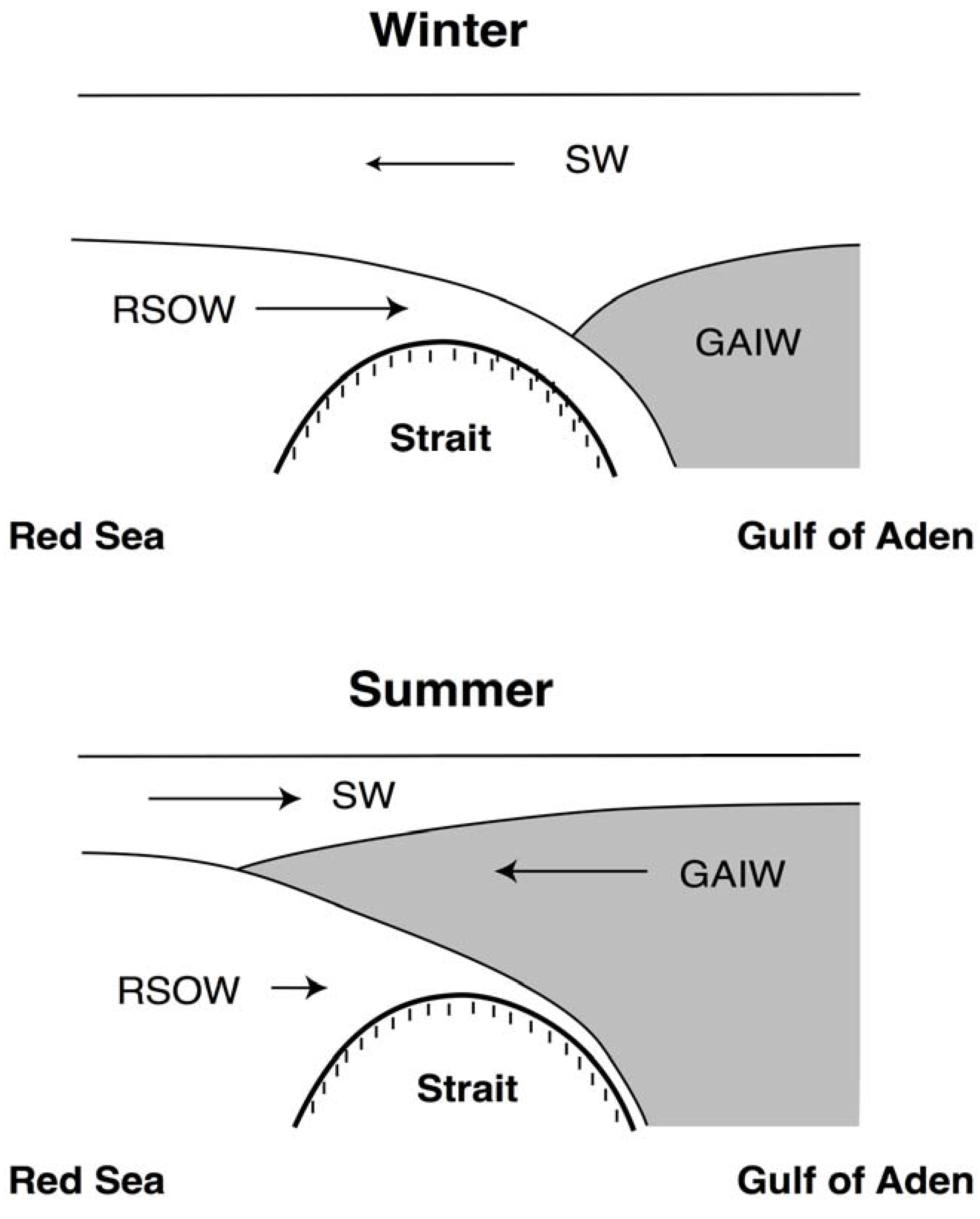
| Region Number | Region Name | North End | South End |
|---|---|---|---|
| 1 | NRS | 27.7°N | 25.5°N |
| 2 | NCRS | 25.5°N | 22°N |
| 3 | SCRS | 22°N | 17.5°N |
| 4 | SRS | 17.5°N | 12.8°N |
| Data Name | Product | Level | Spatial Resolution | Temporal Resolution | Web Link |
|---|---|---|---|---|---|
| MODIS Chl-a (Terra & Aqua) | MOD21/MYD21 | 3 | 4 km | Monthly | https://oceancolor.gsfc.nasa.gov/cgi/l3 |
| OC-CCI V3 data | OC-CCI Chl-a | 3 | 4 km | Daily/Monthly | https://www.oceancolour.org/portal |
| SST | GHRSST | 4 | 0.05° | Daily | http://apdrc.soest.hawaii.edu /las/v6/constrain?var=11674 |
| Wind | ASCAT | 2 | 0.25° | Daily | http://apdrc.soest.hawaii.edu /las/v6/dataset?catitem=11683 |
| Ocean Surface Current | OSCAR | 4 | 1/3° | 5-day | http://apdrc.soest.hawaii.edu/las/v6/constrain?var=2136 |
| HYCOM Model | MLD | - | 1/12° | Daily | http://apdrc.soest.hawaii.edu/las/v6/constrain?var=10471 |
| SSH | - | 1/12° | Daily | http://apdrc.soest.hawaii.edu/las/v6/constrain?var=10472 | |
| MODIS AOD (Terra & Aqua) | MOD04/MYD04 | 2 | 3 km | Daily | https://worldview.earthdata.nasa.gov/ |
© 2017 by the authors. Licensee MDPI, Basel, Switzerland. This article is an open access article distributed under the terms and conditions of the Creative Commons Attribution (CC BY) license (http://creativecommons.org/licenses/by/4.0/).
Share and Cite
Li, W.; El-Askary, H.; ManiKandan, K.P.; Qurban, M.A.; Garay, M.J.; Kalashnikova, O.V. Synergistic Use of Remote Sensing and Modeling to Assess an Anomalously High Chlorophyll-a Event during Summer 2015 in the South Central Red Sea. Remote Sens. 2017, 9, 778. https://doi.org/10.3390/rs9080778
Li W, El-Askary H, ManiKandan KP, Qurban MA, Garay MJ, Kalashnikova OV. Synergistic Use of Remote Sensing and Modeling to Assess an Anomalously High Chlorophyll-a Event during Summer 2015 in the South Central Red Sea. Remote Sensing. 2017; 9(8):778. https://doi.org/10.3390/rs9080778
Chicago/Turabian StyleLi, Wenzhao, Hesham El-Askary, K. P. ManiKandan, Mohamed A. Qurban, Michael J. Garay, and Olga V. Kalashnikova. 2017. "Synergistic Use of Remote Sensing and Modeling to Assess an Anomalously High Chlorophyll-a Event during Summer 2015 in the South Central Red Sea" Remote Sensing 9, no. 8: 778. https://doi.org/10.3390/rs9080778






